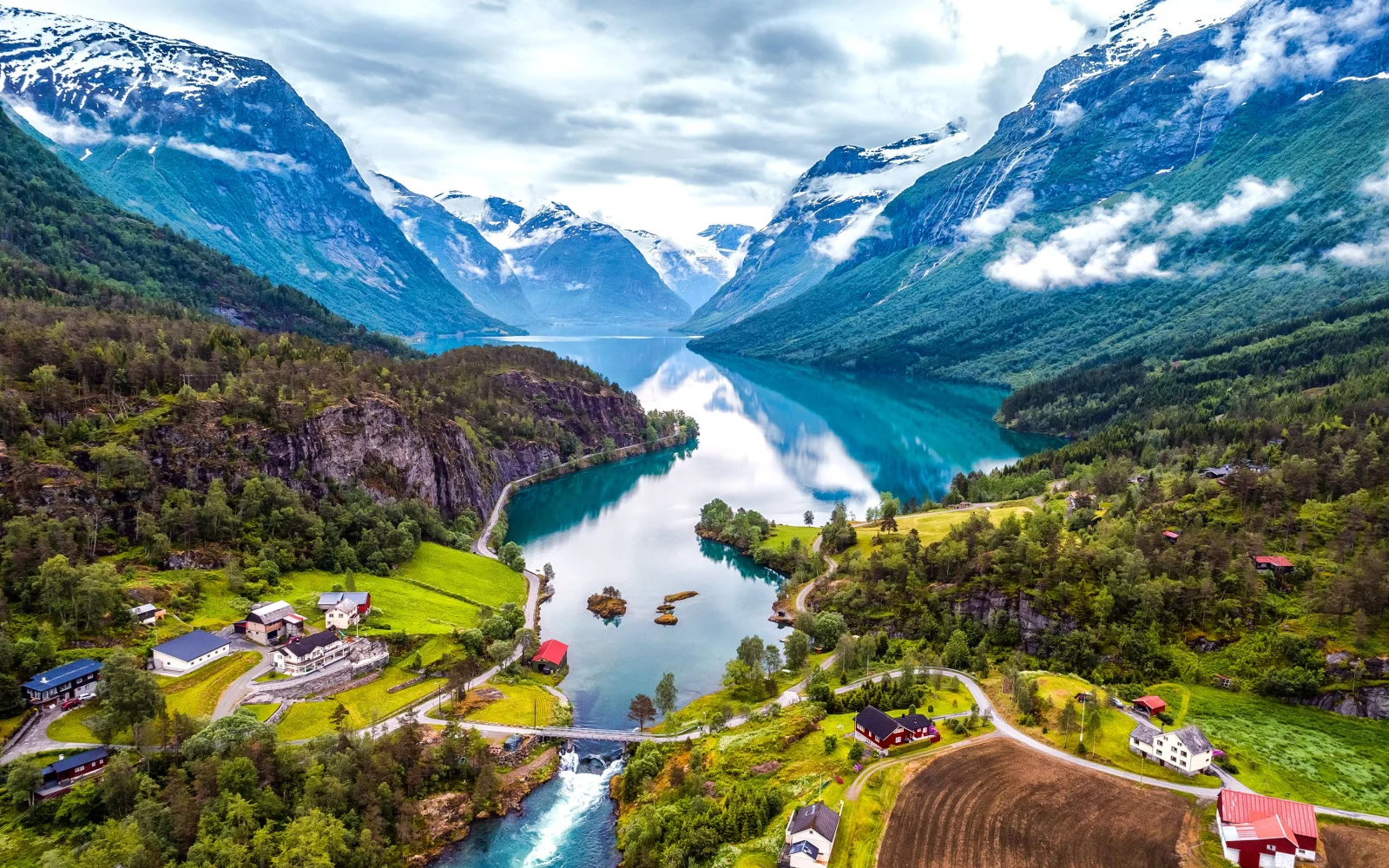Norway — the celebrated land of Vikings and fjords — is famous for its breathtaking vistas and rugged coastline. For travelers seeking outdoor activities and natural beauty, the country is something of a paradise.
But in the last 50 years, this mountainous far-northern nation (and indeed, much of Scandinavia) has become well-known for something else — sky-high prices.
In fact, by some measures, Norway is one of the top three most expensive countries in the world.
In the 20th century, Norway’s oil wealth enabled it to become one of the wealthiest nations in Europe per capita, and this wealth (as well as super-high taxes) has led to incredibly steep prices for everything from housing to food.
While Norway was never a cheap country to visit within the last century or so, it’s definitely the opposite of affordable today, although some countries in Europe (such as Switzerland and Monaco) still surpass it in terms of cost of living.
Fortunately for travelers, some prices have fallen by up to a third in U.S. dollar terms in the last five years (Oslo is no longer on the list of the top 20 most expensive cities in the world).
Norway is no longer the most expensive Nordic country to live in anymore (that honor now goes to Iceland).
But don’t worry — you can still travel to here without spending a fortune and still experience some of the best attractions and qualities this country has to offer. Let us be your guide!
Average Trip to Norway Cost in 2025
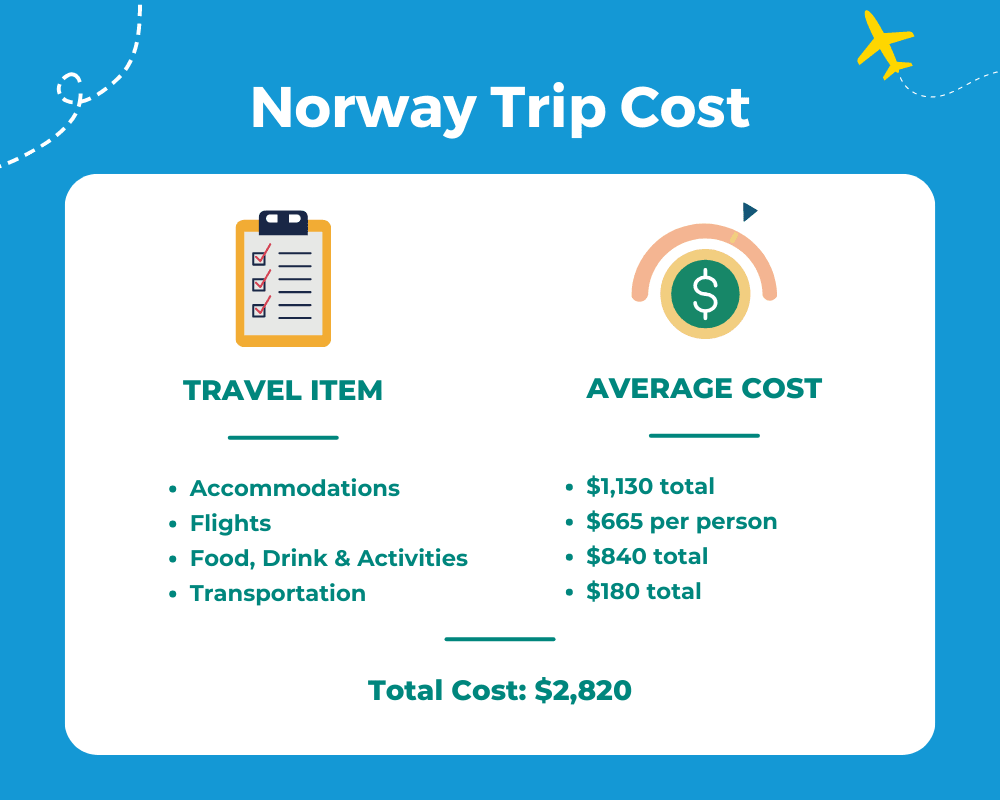
An average seven-day vacation for one person in Norway will cost a bit more than $2,800. This can be broken down as follows:
- Average Accommodation Cost: $1,130
- Average Flight Cost: $665
- Food, Drinks & Activities: $840
- Transportation: $185
- Total Cost: $2,820
Of course, these figures are more slanted toward tours of the urban centers of Norway than those foraying into the more remote regions, which can sometimes be cheaper.
While they only factor in one person, the transportation and accommodation costs will scale with more people on the trip. Many people compare and contrast Norway to its eastern neighbor, Sweden, but Norway is the more scenic and pricier of the two nations.
It’s worth remembering that citizens of Norway speak Norwegian, while citizens of Sweden speak Swedish, but both languages (as well as Danish) are descended from Old Norse, so most of each country’s residents can understand one another.
It’s certainly easy to cross the border from one land to the other, and many residents of each country do this daily!
Norwegian Trip Cost: Average by Item
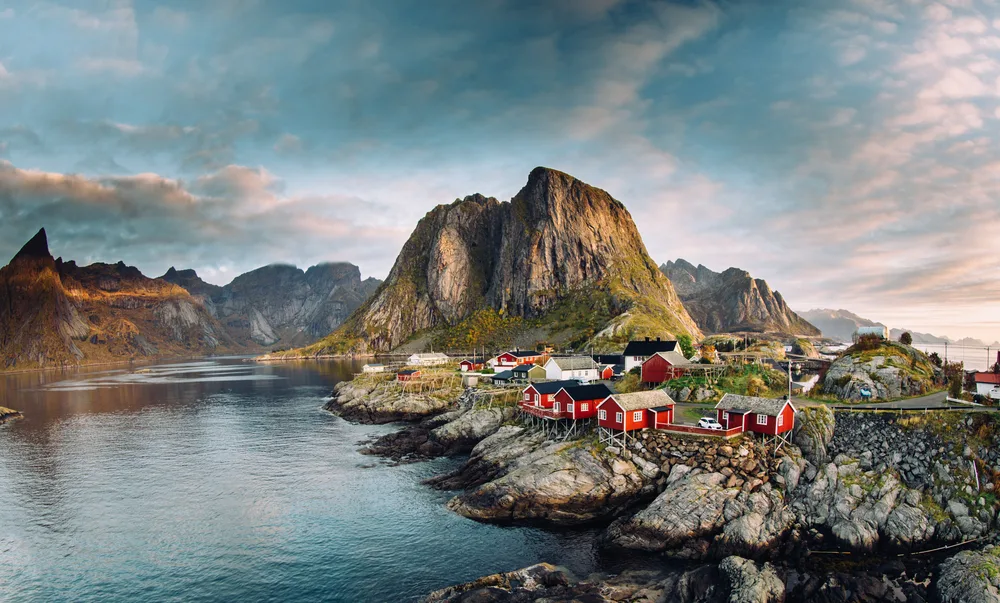
Yari2000/Shutterstock
Accommodation Costs
Depending on where you stay in Norway, accommodation costs don’t have to set you back as much as they might in other Western European nations.
For instance, a mid-range hotel in Norway might be a relatively affordable $120 per night, while a four- or five-star property could be $225 per night. Of course, a lot depends on where you’re staying.
Prices in the capital city of Oslo will be higher than in smaller cities, such as Bergen or Trondheim, which themselves will likely be more expensive than lodging in smaller towns.
For those on a budget, lower-priced hotels might be $95 per night on average, while family or youth hostels (many of which are favorable to backpackers) are roughly $50 per night.
For travelers who really want to save money and/or experience the great outdoors, another option is camping. You can also consider renting a camper van for about $140 per day, which would also take care of many of your transportation needs.
For all of the above options, it pays to book months in advance, particularly if you’re traveling during the summer (the height of the tourist season).
If you can, try to get accommodation that includes breakfast; this will allow you to save on food expenses (see below), which can be significant!
Flight Costs
The best (and most expensive) time of year to visit Norway is the summer, when temperatures are warm and the days are long (see “Things to Consider” below).
But keep in mind that summer is the high season, whereas the cheapest month to travel to Norway is January.
For comparison purposes, roundtrip flights from New York City to Oslo in summer might cost around $525, whereas in winter, they might be only $400. Budget airlines like Norse Atlantic and Frontier may offer cheaper fares.
Of course, it helps to book your tickets ahead of time — ideally at least 45 to 60 days in advance — so if you’re planning on traveling in June, it would be best to book your flight by April.
Another tactic to lower your costs could be to fly to London and then take one of the cheap intra-European airlines like Easyjet or Ryanair on to Norway (many Easyjet flights are $50 or even less if you don’t have tons of luggage).
Food, Drink & Activity Costs
Although it’s true that some prices in Norway have fallen in U.S. dollar terms over the last five years, food costs (especially for meat and dairy products) are not among them.
Plainly speaking, food in Norway can be 50% to 100% more expensive than it is in neighboring countries.
In fact, food, drink, and other consumables can be so costly in Norway that it’s not unheard of for Norwegians to travel to neighboring Sweden to buy these items. For these reasons, you should likely budget a minimum of $50 per day for food alone for your trip.
You can save money if you eat at Norwegian kafeterias and kiosks as well as fish markets (where some fish will be cooked versus raw) or if you buy food at supermarkets instead of eating out.
Beyond food, alcohol is also notoriously expensive in Norway. For example, a standard beer at a bar may cost $9, and a glass of wine $8. Overall, alcohol can be 120% more expensive in Norway than in other European nations.
A history of less frequent but heavier drinking by Norwegians has led to strict government regulation, high taxes, and pricing controls for alcohol. In terms of activities, it depends on what you want to do in Norway.
Because of large subsidies from the government, many of Norway’s museums are free. The Norwegian word friluftsliv (meaning “outdoor life”) characterizes Norwegians’ love for the outdoors.
Exploring the country’s historic urban neighborhoods, remote countryside, and national parks doesn’t cost anything, but skiing and snowboarding can both be somewhat expensive undertakings.
It’s also free to view the famous Northern Lights (which are visible in the winter months and not the summer), but you’ll get a much clearer view of these outside the larger cities than within them (especially in the north of the country in either September or March).
Transportation Costs
Transportation in Norway can be a large expense, as most public transit within the nation’s borders isn’t cheap. But you can usually save money by booking ahead of time.
Cruises through the fjords can offer pretty scenery, but some of the larger ferries can provide the same views for much less money. The famous Hurtigruten ferry stops in 34 ports but is slightly on the more expensive side.
Note that many cruise and ferry prices can fluctuate seasonally. Trains in Norway go to lots of places, but they can also be pricey.
A cheaper option for them is to get a rail pass that will let you take whichever routes you select (although some long-distance routes may still require separate reservations).
The Norway Pass from Eurail/Interrail specifically will allow you to save money on most of Norway’s trains. The downloadable Entur app will let you plan a trip that takes into account not just trains, but multiple transit modes.
The cheapest form of transportation in Norway is buses. There’s an extensive network of local and express coaches that cover the country, and night buses run when regular public transit stops.
Oslo’s Ruter transit network includes local and regional buses, as well as the Oslo metro, tram lines, and some ferries. An unlimited ticket valid for 24 hours on this network costs $11.
For $45, you can get the Oslo Pass, which also gives you unlimited travel as well as access to many of the large museums and tourist attractions.
There are discounts if you’re part of a family, a student, or a senior citizen. For accessing Norway’s remote regions, you’ll need to rent a car. But beware of winter conditions and narrow or closed roads.
There are tolls, and gas prices are the second-highest in the world at roughly $10/gallon (despite Norway being a major petroleum producer).
The more remote the area you travel to, the more expensive transportation costs tend to be. Know that longer (more days) car rentals can be cheaper per day than rentals for just one day.
Electric vehicles (EVs) are tremendously popular in Norway, and renting one can save you in terms of fuel costs. You can rent bicycles (including e-bikes) in Norway for between $30 and $85 per day at bike shops, hotels, campsites, and tourist information centers.
Things to Consider
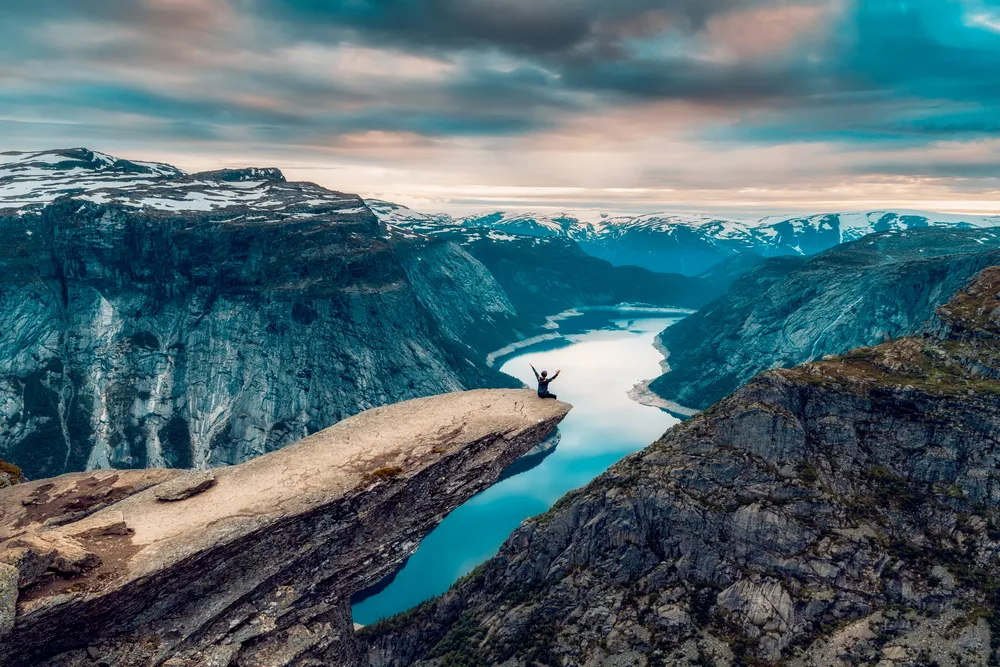
Snapshopped/Shutterstock
Norway is famously called the Land of the Midnight Sun due to how far north it’s located. This means that during the height of the summer, due to the tilt of the Earth’s axis, the sun never completely sets.
The effects of this are more noticeable the more northward you go, but Norwegians make good use of blackout curtains and eye masks to combat this.
In the winter, the effect is just the opposite, and in Oslo, the nights can last nearly 18 hours, while the north of the country sees even less sunlight. The Norwegians compensate for this by embracing the dark, engaging in more outdoor activities, being social, and using more artificial light.
Norway does not use the Euro; it instead uses its own currency, the Norwegian Krone (NOK). Although cash is still used in Norway, many people pay for almost everything with cards.
Therefore, if you want to use cash, change your money into NOK at your local bank (if possible) before you leave.
But more importantly, bring cards with you that are branded with either the Visa or Mastercard logo, as machines that take American Express or Discover cards can only be found in the largest cities.
It’s smart to let your bank know you’ll be traveling to Norway ahead of time so they don’t block or flag spending on your credit cards there as “suspicious activity.”
If you try to use ATMs (known as “minibanks”), they can be difficult to locate, and the fees can be steep, but mostly because the charges are imposed by American banks, not the local ones.
Because Norway is a relatively expensive place, take into account all extra and ancillary costs for your trip, such as taxes, commissions, fees, tips, extra charges, etc. These costs can be inexpensive individually, but they can add up, so be sure to leave room in your budget for them.
Be aware that tipping is common in Norwegian restaurants (10-15%) but not so much in bars.
Frequently Asked Questions
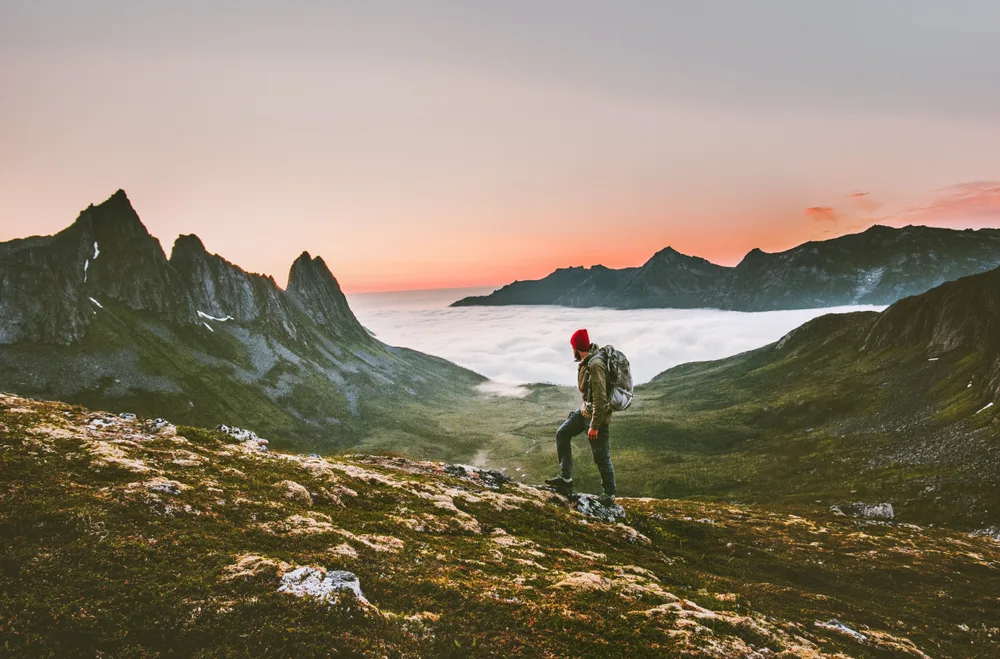
Everst/Shutterstock
How cold is it? What is the weather like?
Bear in mind that nearly half of Norway lies within the Arctic Circle. The snowy regions of the country are where they shot the ice planet scenes for the Star Wars film The Empire Strikes Back.
Summer temperatures average between just 57 and 65 degrees Fahrenheit, while winter temperatures range from 23 to 32 degrees, with some remote northern areas of the country getting as cold as -60 degrees.
You should definitely pack some waterproof clothes and remember the Norwegian saying, “There’s no such thing as bad weather, only bad clothing.”
What are the Norwegian people like? Are they friendly?
By and large, Norwegians are known to be warm and welcoming people, despite sometimes being stereotyped as quiet and stoic. Getting to know them can take a bit of effort, but doing so will allow you to see Norway from a whole new perspective.
Do people speak English?
Yes, just about every Norwegian (except for some members of the elderly population) is fluent in English, with the nation ranking third in Europe and fourth in the world in terms of proficiency with the language.
Are there reindeer?
Yes, Norway is home to more than 1.2 million reindeer. The indigenous Sámi people still herd reindeer and use them to pull sleds. You can visit the Tromsø Arctic Reindeer Center and pet and feed the reindeer there.
Do people eat whale meat?
Yes, Norwegians still practice whaling (within strict quotas), and many people eat whale meat at least once a year (it’s also given to animals and exported to other countries). The annual catch is roughly 500 whales per year.
So, What Is the Cost of a Norwegian Trip?
| 🛎️ Average Accommodation Cost | $1,130 total |
| ✈️ Average Flight Cost | $665 per person |
| 🍽️ Food, Drink & Activities | $840 total |
| 🚕 Transportation | $185 total |
| 💲 Total Cost | $2,820 |
To summarize much of the above information, a trip to Norway will cost between $125 and $335 per day, depending on what type of accommodation you choose, how expensive your meals are, and what you choose to do while you’re there.
If you go to Norway to camp, hike, and experience the great outdoors, you’ll probably end up spending less than if you take an expensive cruise through the fjords.
The country is a big place with a lot to offer visitors; getting a guidebook to the country is a good way to start planning a trip! We’re sure that it’ll be one to remember for the rest of your life. Happy travels!



